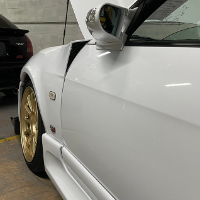R33 Gtst Speedo Sensor Resistor Vaule
Announcements
-
Similar Content
-
Latest Posts
-
Try looking at Eibacb/H&R springs Thats what Gary sourced for mine.
-
Hey y'all! I'm curious about how y'all go about widebodying your cars. I noticed that when running a square setup, my front wheels are a bit more tucked in than my rear wheels. Not by much, maybe 5-10mm. This leads me to wonder - when I widebody, should I use narrower front flares and wider rear flares? I found a set of 40mm rear flares that I really like, and was thinking of pairing them with some 18mm front flares, but I don't want the car to look strange. How have others done this? Note, I'm in a sedan. Thanks!
-
And if it was anything other than an auto tranny part, it might be a problem. But seeing as all auto trannies belong in the recycling bin, it's fine.
-
All the schemas I can see, indicate your typical setup of ATF 'cooler' (read: heat exchanger) in the bottom radiator tank..ie; https://nissan.epc-data.com/stagea/wgnc34/5413-rb25det/engine/214/ ...but I can prattle on a bit here. These trannies have a thermistor in the sump ~ the TCU reads this and 1. bumps the line pressure up when the ATF is 'cold' and 2. prevents the TC lockup clutch from operating, until the ATF comes up to minimum operating temp (keeps the ATF 'churning' through the TC so it heats up quicker) -- trigger point is around 55C. In these conditions, the engine coolant temperature rises faster than the ATF temperature, and also helps heat the ATF up, which is why it's best to think of the in radiator tank setup as a heat exchanger ; the heat can flow in both directions... ...with these trannies, the 'hot' ATF comes out the front banjo bolt, flows through the cooler/heat exchanger, and returns to the box via the rear banjo bolt. This gets a mention, due to the wildly different opinions wrt running auto trans fluid coolers ~ do you bypass the in radiator tank altogether, or put the cooler inline with the in radiator tank system...and then, do you put the additional cooler before of after the in radiator tank system?... ....fact is the nominal engine operating temp (roughly 75C), happens to be the ideal temperature for the ATF used in these trannies as well (no surprises there), so for the in radiator tank system to actually 'cool' the ATF, the ATF temp has to be hotter than that...lets say 100C -- you've got 25C of 'excess' heat, (slowly) pumping into the 75C coolant. This part of the equation changes drastically, when you've got 100C ATF flowing through an air cooled radiator ; you can move a lot more excess heat, faster ~ it is possible to cool the ATF 'too much' as it were...(climate matters a lot)... ...in an 'ideal' setup, what you're really trying to control here, is flash heating of the ATF, primarily produced by the TC interface. In a perfect world, wrt auto trans oil cooling, you want a dedicated trans cooler with builtin thermostatic valving - they exist. These should be run inline and before the in radiator tank system ~ when 'cold' the valving bypasses the fin stack, allowing the ATF to flow direct to the in radiator tank heat exchanger, so it works 'as intended' with helping heat the ATF up. When 'hot' (iirc it was 50C threshold), the valving shuts forcing the ATF through the cooler fin stack, and onto the in radiator tank heat exchanger...and you sort of think of it as a 'thermal conditioner' of sorts...ie; if you did cool your ATF down to 65C, the coolant will add a little heat, otherwise it works as intended... ...the 'hot' ATF coming from the front bango bolt, is instantiated from the TC when in use, so all/any flash heated oil, flows to the fluid-to-air cooler first, and because of the greater heat differential, you can get rid of this heat fast. Just how big (BTU/h) this cooler needs to be to effectively dissipate this TC flash heat, is the charm...too many variables to discuss here, but I just wanted to point out the nitty-gritty of automatic trans fluid coolers ~ they're a different beastie to what most ppl think of when considering an 'oil cooler'... /3.5cents
-







Recommended Posts
Create an account or sign in to comment
You need to be a member in order to leave a comment
Create an account
Sign up for a new account in our community. It's easy!
Register a new accountSign in
Already have an account? Sign in here.
Sign In Now